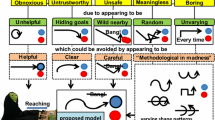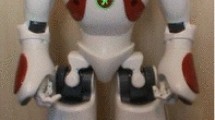Abstract
Robots designed to co-exist with humans in domestic and public environments should be capable of interacting with people in an enjoyable fashion in order to be socially accepted. In this research, we seek to set up a small humanoid robot with the capability to provide enjoyment to people who pick up the robot and play with it by hugging, shaking and moving the robot in various ways. Inertial sensors inside a robot can capture how its body is moved when people perform such “full-body gestures”. Unclear is how a robot can recognize what people do during play, and how such knowledge can be used to provide enjoyment. People’s behavior is complex, and naïve designs for a robot’s behavior based only on intuitive knowledge from previous designs may lead to failed interactions. To solve these problems, we model people’s behavior using typical full-body gestures observed in free interaction trials, and devise an interaction design based on avoiding typical failures observed in play sessions with a naïve version of our robot. The interaction design is completed by investigating how a robot can provide “reward” and itself suggest ways to play during an interaction. We then verify experimentally that our design can be used to provide enjoyment during a playful interaction. By describing the process of how a small humanoid robot can be designed to provide enjoyment, we seek to move one step closer to realizing companion robots which can be successfully integrated into human society.













Similar content being viewed by others
Notes
Two earlier conference papers first described our approach for recognizing gestures [6] and how this information can be applied [7]. The current article chronicles the whole design process from start to finish in one place, providing additional details, and offers new results needed to support our finding that the proposed solution is effective toward providing enjoyment.
References
Barnett K (1972) A theoretical construct of the concepts of touch as they relate to nursing. Nurse Res 21:102–110. doi:10.1097/00006199-197203000-00002
Brooke J (1996) SUS: a quick and dirty usability scale. In: Jordan PW, Thomas B, Weerdmeester BA, McClelland AL (eds) Usability evaluation in industry. Taylor & Francis, London
Brooks AG, Arkin RC (2007) Behavioral overlays for non-verbal communication expression on a humanoid robot. Auton Robots 22(1):55–74. doi:10.1007/s10514-006-9005-8
Chang C, Hsu C, Lin C (2003) A practical guide to support vector classification. In: Taipei, Taiwan, vol 106
Chang C, Lin C (2001) LIBSVM: a library for support vector machines. http://www.csie.ntu.edu.tw/cjlin/libsvm. Accessed 25 July 2013
Cooney MD, Becker-Asano C, Kanda T, Alissandrakis A, Ishiguro H (2010) Full-body gesture recognition using inertial sensors for playful interaction with small humanoid robot. In: IEEE/RSJ international conference on intelligent robots and systems (IROS 2010), pp 2276–2282. doi:10.1109/IROS.2010.5650081
Cooney MD, Kanda T, Alissandrakis A, Ishiguro H (2011) Interaction design for an enjoyable play interaction with a small humanoid robot. In: 2011 IEEE–RAS international conference on humanoid robots, humanoids, pp 112–119. doi:10.1109/Humanoids.2011.6100847
Cramer H, Mentis H, Fernaeus Y (2010) Serious work on playful experiences: a preliminary set of challenges. In: Fun, seriously? Workshop at CSCW 2010
Csíkszentmihályi M, Rathunde K (1993) The measurement of flow in everyday life: towards a theory of emergent motivation. In: Jacobs JE (ed) Developmental perspectives on motivation. Nebraska symposium on motivation, University of Nebraska Press, Lincoln
Csíkszentmihályi M (1975) Beyond boredom and anxiety: experiencing flow in work and play. Jossey-Bass, San Francisco
Dautenhahn K, Nehaniv CL, Walters ML, Robins B, Kose-Bagci H, Mirza NA, Blow M (2009) KASPAR—a minimally expressive humanoid robot for human-robot interaction research. Appl Bionics Biomech (special issue on humanoid robots) 6(3):369–397. doi:10.1080/11762320903123567
Ellis MJ (1973) Why people play. Prentice-Hall, New Jersey
Festinger L (1957) A theory of cognitive dissonance. Stanford University Press, Stanford
Fujita M (2004) On activating human communications with pet-type robot AIBO. Proc IEEE 92(11):1804–1813. doi:10.1109/JPROC.2004.835364
Garfinkel H (1967) Studies in ethnomethodology. Prentice-Hall, New Jersey
Geldard FA (1960) Some neglected possibilities of communication. Science 131:1583–1588. doi:10.1126/science.131.3413.1583
Goetz J, Kiesler S, Powers A (2003) Matching robot appearance and behavior to tasks to improve human-robot cooperation. In: 2003 IEEE international workshop on robots and human interactive communications (RO-MAN 2003), pp 55–60. doi:10.1109/ROMAN.2003.1251796
Hassenzahl M, Burmester M, Koller F (2003) AttrakDiff: Ein Fragebogen zur Messung wahrgenommener hedonischer und pragmatischer Qualität. In: Mensch & Computer, Interaktion in Bewegung, pp 187–196 (in German)
Hayashi K, Shiomi M, Kanda T, Hagita N (2010) Who is appropriate? A robot, human and mascot perform three troublesome tasks. In: 2010 IEEE international workshop on robots and human interactive communications (RO-MAN 2010), pp 348–354. doi:10.1109/ROMAN.2010.5598661
Heerink M, Kröse BJA, Wielinga BJ, Evers V (2008) Enjoyment, intention to use and actual use of a conversational robot by elderly people. In: Proceedings of the 3rd ACM/IEEE international conference on human-robot interaction (HRI 2008), pp 113–119. doi:10.1145/1349822.1349838
Heider F, Simmel M (1944) An experimental study of apparent behavior. Am J Psychol 57:243–259. doi:10.2307/1416950
Huizinga J (1950) Homo ludens: a study of the play element in culture. Roy Publishers/The Beacon Press, Boston
Kahn PH, Freier NG, Kanda T, Ishiguro H, Ruckert JH, Severson RL, Kane SK (2008) Design patterns for sociality in human-robot interaction. In: Proceedings of the 3rd ACM/IEEE international conference on human robot interaction (HRI 2008), pp 97–104. doi:10.1145/1349822.1349836
Knight H, Chang A, Breazeal C et al (2009) Robot design rubrics for social gesture categorization and user studies with children. In: HRI workshop on acceptance of robots in society
Kozima H, Michalowski MP, Nakagawa C (2009) Keepon: a playful robot for research, therapy, and entertainment. Int J Soc Robot 1(1):3–18. doi:10.1007/s12369-008-0009-8
Kraus MW, Huang C, Keltner D (2010) Tactile communication, cooperation, and performance: an ethological study of the NBA. Emotion 10:745–749. doi:10.1037/a0019382
Kulic D, Ott C, Lee D, Ishikawa J, Nakamura Y (2012) Incremental learning of full body motion primitives and their sequencing through human motion observation. Int J Robot Res 31(3):330–345. doi:10.1177/0278364911426178
Lewis C, Rieman J (1993) Task-centered user interface design: a practical introduction. Internet: HCI bibliography: human-computer interaction resources http://www.hcibib.org/tcuid/index.html. Accessed July 25 2013
Michalowski MP, Sabanovic S, Michel P (2006) Roillo: creating a social robot for playrooms. In: 2006 IEEE international workshop on robots and human interactive communications (RO-MAN 2006), pp 587–592. doi:10.1109/ROMAN.2006.314453
Movellan JR (2005) An infomax controller for real time detection of social contingency. In: Proceedings of the 4th international conference on development and learning (ICDL05)
Nakatsu R, Rauterberg M, Vorderer P (2005) A new framework for entertainment computing: from passive to active experience. In: Kishino F, Kitamura Y, Kato H, Nagata N (eds) Entertainment computing—ICEC. Lecture notes in computer science (LNCS), vol 3711. Springer, Berlin, pp 1–12
Nielsen J, Molich R (1990) Heuristic evaluation of user interfaces. In: Proc. of ACM CHI’90 conference, pp 249–256. doi:10.1145/97243.97281
Nomura T, Suzuki T, Kanda T, Kato K (2006) Measurement of negative attitudes toward robots. Interact Stud 7(3):437–454. doi:10.1075/is.7.3.14nom
Robins B, Dautenhahn K, Boekhorst RT, Nehaniv CL (2008) Behaviour delay and robot expressiveness in child-robot interactions: a user study on interaction kinesics. In: Proceedings of the 3rd ACM/IEEE international conference on human robot interaction (HRI 2008), pp 17–24. doi:10.1145/1349822.1349826
Salter T, Michaud F, Dautenhahn K, Letourneau D, Caron S (2005) Recognizing interaction from a robot’s perspective. In: 2005 IEEE international workshop on robots and human interactive communications (RO-MAN 2005), pp 178–183. doi:10.1109/ROMAN.2005.1513776
Salter T, Michaud F, Letourneau D, Lee DC, Werry IP (2007) Using proprioceptive sensors for categorizing human-robot interactions. In: Proceedings of the 2nd ACM/IEEE international conference on human robot interaction (HRI 2007), pp 105–112. doi:10.1145/1228716.1228731
Satake S, Kanda T, Glas DF, Imai M, Ishiguro H, Hagita N (2009) How to approach humans? Strategies for social robots to initiate interaction. In: Proceedings of the 4th ACM/IEEE international conference on human robot interaction (HRI 2009), pp 109–116. doi:10.1145/1514095.1514117
Shneiderman B, Plaisant C (2004) Designing the user interface: strategies for effective human-computer interaction, 4th edn. Pearson/Addison/Wesley, Boston
Stiehl W, Breazeal C (2005) Design of a therapeutic robotic companion for relational, affective touch. In: 2005 IEEE international workshop on robots and human interactive communications (RO-MAN 2005), pp 408–415. doi:10.1007/11573548_96
Takayama L, Ju W, Nass C (2008) Beyond dirty, dangerous and dull: what everyday people think robots should do. In: Proceedings of the 3rd ACM/IEEE international conference on human robot interaction (HRI 2008), pp 25–32. doi:10.1145/1349822.1349827
Tanaka F, Cicourel A, Movellan JR (2007) Socialization between toddlers and robots at an early childhood education center. Proc Natl Acad Sci USA 104(46):17954–17958. doi:10.1073/pnas.0707769104
Tanaka F, Movellan JR, Fortenberry B, Aisaka K (2006) Daily Hri evaluation at a classroom environment: reports from dance interaction experiments. In: Proceedings of the 1st ACM/IEEE international conference on human robot interaction (HRI 2006), pp 3–9. doi:10.1145/1121241.1121245
Turkle S (2006) A nascent robotics culture: new complicities for companionship. AAAI technical report series
Turkle S, Breazeal C, Scasselati B, Dasté O (2004) Encounters with Kismet and Cog: children’s relationships with humanoid robots. In: 2004 IEEE–RAS international conference on humanoid robots (Humanoids 2004)
Venkatesh V (2000) Determinants of perceived ease of use: integrating control, intrinsic motivation, and emotion into the technology acceptance model. Inf Syst Res 11:342–365. doi:10.1287/isre.11.4.342.11872
Viola P, Jones M (2001) Robust real time object detection. In: IEEE ICCV workshop statistical and computational theories of vision, Vancouver, Canada
Vorderer P, Klimmt C, Ritterfeld U (2004) Enjoyment: at the heart of media entertainment. Commun Theory 14:388–408. doi:10.1111/j.1468-2885.2004.tb00321.x
Wada K, Shibata T (2007) Living with seal robots-its sociopsychological and physiological influences on the elderly at a care house. IEEE Trans Robot 23(5):972–980. doi:10.1109/TRO.2007.906261
Watson D, Clark LA, Tellegan A (1988) Development and validation of brief measures of positive and negative affect: the PANAS scales. J Pers Soc Psychol 54(6):1063–1070. doi:10.1037/0022-3514.54.6.1063
Williams LE, Bargh JA (2008) Experiencing physical warmth promotes interpersonal warmth. Science 322:606–607. doi:10.1126/science.1162548
Yi MY, Hwang Y (2003) Predicting the use of web-based information systems: self-efficacy, enjoyment, learning goal orientation, and the technology acceptance model. Int J Hum-Comput Stud 59(4):431–449. doi:10.1016/S1071-5819(03)00114-9
Yohanan S, MacLean KE (2012) The role of affective touch in human-robot interaction: human intent and expectations in touching the haptic creature. Int J Soc Robot 4(2):163–180. doi:10.1007/s12369-011-0126-7
Vapnik V, Golowich S, Smola A (1996) Support vector method for function approximation, regression estimation, and signal processing. Adv Neural Inf Process Syst 9:281–287
Acknowledgements
We would like to thank everyone who helped with this project. This research was supported by the Ministry of Internal Affairs and Communications of Japan and JST, CREST.
Author information
Authors and Affiliations
Corresponding author
Rights and permissions
About this article
Cite this article
Cooney, M., Kanda, T., Alissandrakis, A. et al. Designing Enjoyable Motion-Based Play Interactions with a Small Humanoid Robot. Int J of Soc Robotics 6, 173–193 (2014). https://doi.org/10.1007/s12369-013-0212-0
Accepted:
Published:
Issue Date:
DOI: https://doi.org/10.1007/s12369-013-0212-0




